Wood Blewits
By Mike on Monday, November 9, 2015, 00:13 - Permalink
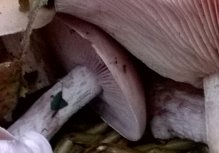
Here's an interesting thing - Blewits are supposedly quite a common woodland mushroom - and I spend a fair bit of my foraging time in woodland - these should have been one of the first mushrooms I wrote about, but despite looking, I never managed to find them, until now.
Identification Of Wild Fungi
The description here is not intended to be sufficient for conclusive identification of these wild fungi - the reader should understand that the possible outcomes of misadventure with wild-gathered fungi include serious illness and death.IT IS YOUR OWN RESPONSIBILITY to take adequate steps in identifying any fungi you gather for the table - doubly so if you are intending to share them with someone else.
Informal descriptions, such as the one on this page, are not adequate for full identification - it's just good sense to fully and independently verify everything you read here.
Rules of thumb or folk wisdom identification methods are frequently unreliable.
Consult a comprehensive identification guide (I recommend Roger's Mushrooms (site no longer available - see here) and Wild Mushrooms Online) or best of all, talk to a living human expert mycologist.
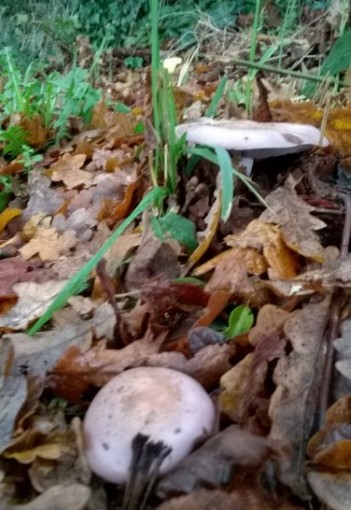
Out for a Sunday afternoon walk, I spotted a patch of mushrooms pushing their way up through the leaf litter beneath some oak trees in a shady wood edge.
They had a bluish-lilac tinge to the caps - especially the younger specimens - could it be that I had finally found Wood Blewits?
What Are Wood Blewits?
Clitocybe nuda (although most of my books refer to it by the deprecated name Lepista nuda) - this fungus grows in piles of decaying leaf litter. This rather neatly attractive mushroom has variable colour that can be pink, pale lilac or buff (or any combination of these).
The cap is up to about 15cm in diameter - becoming convex and wavy as it matures - the stem is stiff and fibrous, but breaks apart or crushes easily (I first suspected that my specimens had been infested by maggots, but this turned out to be the normal texture of the stalk). The top of the cap is slightly sticky when moist.
The base of the stalk is often asymmetrically bulbous and (because it grows in leaf litter) is easily uprooted, revealing the fluffy whitish mycelia.
Apart from the colour, the most distinctive attribute of this fungus is the smell. My books describe it as 'scented' or 'strongly perfumed'.
The smell was certainly conspicuous, but I found it really hard to pin down and describe - at times, it was just richly mushroomy, but on breaking the flesh, I thought I detected hints of mango - but when I went back for another sniff, I thought maybe it was more like lavender.
When I cut them up to cook them, the bowl of cut pieces had a smell a bit like fresh green apples, but always with a funky, mushroomy, forest-floor note to it.
Suffice to say that this mushroom is fragrant in a fruity-perfumed-mushroomy way that, once you experience it, you won't soon mistake for anything else.
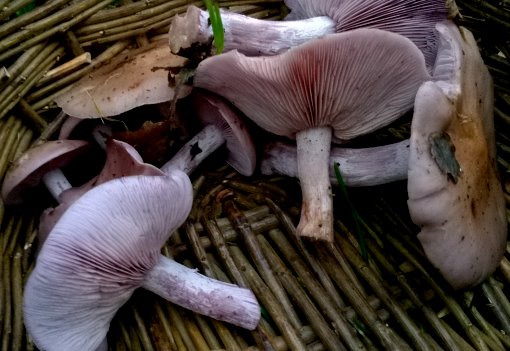
I picked half a basketfull of these beautiful mushrooms.
Unless required for later identification, I always cut the base of the stalk off my mushrooms before placing them on their sides in the basket.
This means that if they tip over upside down, there's less chance of dirt falling into the gill structures, which would make them unpleasant to eat.
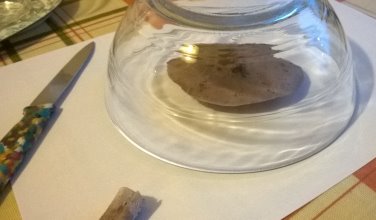
Positive ID
Blewits can possibly be mistaken for one or more species of Cortinarius, which are found in similar habitats, and have purplish colouration and generally similar appearance.
The Cortinarius species don't have the distinctive smell of Blewits, but if you've never experienced that, what do you do?
Spore Print
The definitive test is a spore print. Trim off the stalk of one of the mushrooms and place it gills-down on a sheet of paper or card, and cover it with a cup or bowl to isolate it from air currents which might blow the spores away.
Leave it like that for a couple of hours, then carefully lift away the bowl and examine the spore print. Cortinarius spores are rich, rusty brown in colour; Blewits have spores that are creamy-buff to pale pink in colour...
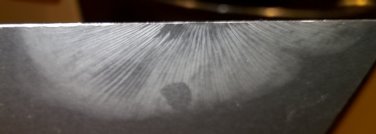
...So pale in fact that my first spore print on white paper wasn't visible at all. In order to determine that there even was a spore print being produced, I tried again, this time, slipping a piece of black card under half the mushroom.
And there is is - a pale creamy-buff spore print. Definitely not Cortinarius then. Off to the kitchen!
First though, let's just take another look at these mushrooms - they really are about as neat and pretty a fungus as you might ever hope to meet - especially the young specimens - perfectly round, very handsomely convex, with tidy and orderly gills, and a subtle, but pretty stylish sense of colour co-ordination.
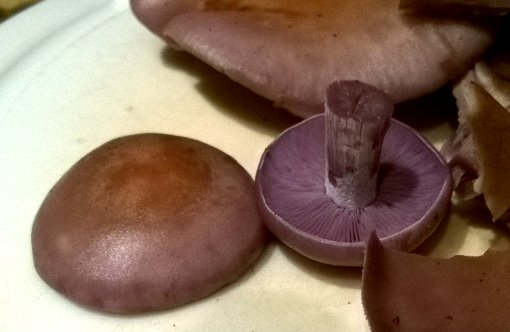
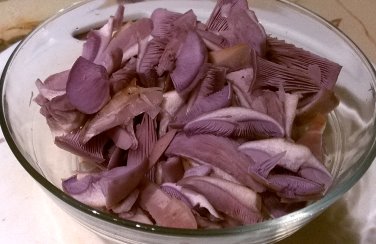
But on with the show!
Cooking Blewits
I wiped the tops of the mushrooms with a moistened paper towel to remove traces of dirt and leaves, then sliced them into pieces.
(This was the point at which the aroma was most notable and fruity).
I also chopped up a couple of shallots and fried them a little in a little butter, then turned up the heat and tipped in the mushroom pieces.
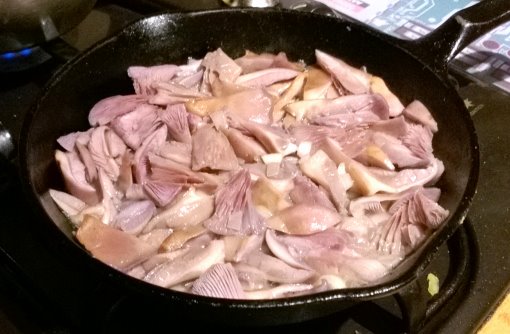
They very quickly shrank down in size and released quite a lot of liquid. I kept going and cooked them hot until this was reduced down to a glossy coating and the mushrooms were soft and beginning to break apart.
Proper Cooking
At this point, it should be noted that this species of mushroom requires full and thorough cooking before it is eaten.
Blewits will make you ill if you eat them raw or undercooked.
I added a pinch of salt, a good couple of grinds of black pepper, a sprinkling of mixed dried herbs, then a dash of brandy (and flamed off the alcohol), then I added a little cream and simmered to reduce yet further.
I placed the creamy mushroom mixture into the bottom of ramekins, then added a layer of crushed cooked potato, a little butter and a few shreds of grated cheese and placed them under the grill to brown and crisp up the top.
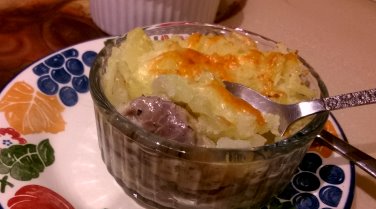
The Tasting, And The Verdict
Well... after all that, I have to say: this is not my favourite mushroom.
I found the texture a little bit too soft and slippery - almost slimy.
Also, the flavour was just... weird. I suppose I like my mushrooms to be either deeply and robustly savoury - like the Cep, or subtle and mild as a foil for other flavours - like the Oyster Mushroom.
Blewits, however, retain their distinctive perfumed flavour through cooking, and I just didn't really like it that much.
So I am glad to have satisfied my curiosity, and happy to have met this pretty little fungus in the real world, but I probably shan't pick it again - I'll focus my efforts elsewhere - both the new, and the other species that I already know and love.
